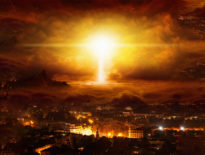The idea of the end of the world refers to the end of the social order and humanity; the end of the planet as we know it. But according to the Bible, these will not all come at once.
The Bible speaks of two stages, delineated by a period called the “millennium.” The second coming of Christ will take place prior to the millennium. It will bring the end of the social order, the death of the last generation, and the resurrection of the righteous (i.e. the first resurrection, according to biblical language), who, together with the living saints, will be saved and taken to heaven.
During the millennium, the judgment of all those who are not resurrected and saved at the coming of Christ will take place in heaven. After the millennium, all people will be resurrected (that is, the second resurrection, in biblical terms) in order to execute their sentence—the death of all who have rejected the salvation of Christ. This is followed by the end of the planet, not a disintegration, but a restoration of its foundations.[1]
The relationship between the coming of Christ and the millennium, on the one hand, and the character of this period of time called the millennium, on the other, has not always been understood in the same way by all Christians. In this article, I will briefly present three models that have dominated Christian history in different periods.
The millennium in late antiquity and modernity
The millennial (or chiliast) dream—to have a millennium of peace and prosperity here on earth—is very old.
Papias (60-130 AD), an apostolic father who interacted with the apostle John and whose work remains only in fragments quoted by Eusebius of Caesarea (c. 260-c. 239), understood the millennial rule of Christ as earthly and material. Eusebius called these ideas “strange teachings”.[2] But Papias was not alone. Justin the Martyr (100-165 AD) believed that after the coming of Christ and the resurrection of the righteous, Jerusalem would be rebuilt, enlarged, and developed for 1,000 years (according to Isaiah 65:17-25)[3]. Tertullian (c.160-230 AD) believed that the millennium began with the coming of Christ and the resurrection of the righteous, but that it would be spent here on earth, the saints living in the New Jerusalem built by God Himself.[4]
In the same sense, Lactantius (250-325 AD), the teacher of the son of Constantine the Great, believed that the 1,000 years would begin after the coming of Christ and the destruction of the wicked.[5] During this time, the saints would multiply and enslave the remaining nations. At the other end of morality, a millennium of material pleasures and carnal indulgences was glimpsed by a heretic named Cerinthus (50-100 AD). For him, the millennium was a time of partying and immorality.[6] Similarly, Nepos of Arsinoe, a bishop of Egypt, taught his followers that the promises of Scripture must be understood in a more Jewish way and that the millennium will be a time of luxurious and lax life here on earth.[7] Chiliasm was strong from the time of the apostolic fathers until the fifth century AD. Jerome (c. 347-420 AD) thundered against this current, which was already fading away at that time.
Commenting on Daniel chapter 7, Jerome wrote: “The four kingdoms I spoke of above were earthly. …But the saints will never be in possession of an earthly kingdom, only of a heavenly one. Then, done with the invention of millenarianism.”[8]
Indeed, the millenarian dream, or chiliast, died out in the fifth century, but was reborn in the eighteenth century, as if from ashes, in the context of the first revival movement (1730 and 1740).
Important leaders from several Christian denominations, such as George Whitefield (1714-1770), John Wesley (1703-1791) and Jonathan Edwards (1703-1758), spoke from a millennial perspective. The second great revival (1790-1840) further underlined these aspirations. Interfaith associations were the main vehicle through which American Protestants wanted to make their country a global example of an authentic republic.[9]
Two great figures of this period were Timothy Dwight (1752-1817), nephew of Jonathan Edwards, and Charles G. Finney (1792-1875).
While the revival brought great benefits in the area of personal religion, on a theoretical level it was an accommodation with the spirit of the times in terms of eschatology. The Enlightenment ideals of a rational order contradicted the idea of an imminent end of the world that had been very popular until then. Theologians began to write and preach about the reasonable character of the Christian God who is more interested in leading the world willingly than in annihilating it in an unexpected way. The millennial God does not use force, but rather persuasion.
Around 1843, Finney argued that if Christ were to come prematurely, and most people ended up in hell, God’s justice and goodwill would be called into question. Instead, the Creator will pursue the happiness of mankind, and the millennium will bring about a quasi-universal conversion of the world.[10]
As expected, with the American Civil War (1861-1865), the idea of persuasion, in contrast to force, faded, and the millenarian ideal fell into disrepute.
In the 19th century, American colonisation was in full swing, Russia was conquering Siberia, and Christian peoples were expanding their territories into Latin America, Africa, and Asia. The geographically widespread Christian presence, the fall of the Ottoman Empire, the British occupation of India, the Christian mission to Japan and South Korea, the entry of the gospel even into China by Hudson Taylor, and the emergence of biblical societies, seemed to herald the dominion of Christianity in the world. Messianic-millenarian dreams were fed politically in the USA, England, Germany, Russia and France.
But the two world wars drastically changed the facts. Hope and optimism gave way to resignation and pessimism. Internal divisions among some of the imperialist nations followed.[11] The colonized nations began to remove the yoke of the occupiers, gaining their independence. The “Auschwitz phenomenon” suppressed the Christian dream of returning Jews to Christ. The destruction of Europe through war, the atomic bomb, and the nuclear explosion at Chernobyl ruined every bright prospect in history and introduced apocalyptic prospects and an end that could happen at any time.[12]
The spiritual coming of Christ into the soul
Millennial dreams were opposed to the idea that Christ comes at the level of personal human experience and that the end is the end of life without God, not the end of history or the planet. Allegory, as a way of interpreting biblical language, was born in Alexandria.
The most representative church father adept at this type of thinking is Origen. In his commentary on the Gospel of Matthew, he suggests that Christ will return when the word of God is spread and received. He says he does not want to deny the simple meaning of Christ’s return, but implies that there is a deeper meaning to His return, and it is not the cosmic one.[13] As Paul Landa says, for Origen, “the parousia will not happen at a certain time, in a certain place, in the future”.[14]
Opposing millennial ideas on eschatology, Origen ended up preaching a Christian form of Gnosticism, in which perfection becomes the ultimate goal. This perspective was not robust enough to withstand criticism, but returned later through the most influential theologian of the twentieth century, Rudolf Bultmann.
In the atomic age in which Bultmann wrote, the end of the world seemed more like a scenario of the human abuse of science and technology than a cosmic event. The eschatological preaching of the New Testament was rendered in terms that by the twentieth century had become unintelligible.
In Geschichte und Eschatologie, Bultmann states that the New Testament presents the event of Jesus Christ as eschatological, as a divine act that puts an end to the ancient world. Through faith, eschatology becomes present, and the old world perishes. This would be the end of the world for the believer—the fact that the old self dies and becomes a new and free creation.[15] This is the paradox of the Christian proclamation, according to Bultmann, that the true meaning of eschatology has not been understood. The escaton would not be an external event to come, but an opportunity given to the individual to decide to lead an authentic existence.[16]
As Carl Henry suggests[17], taken to its logical conclusion, this vision replaces transcendence and metaphysics with the inner decision of the individual, and the cosmic dimension of the end and eternity with a subjective decision. It is not surprising that this way of thinking, as Henry says, has created real confusion in evangelical theological circles.
The degradation of the world and the literal coming of Christ
Scripture supports neither the millennial dream nor the symbolic coming of Christ into the soul. According to Scripture, the end of the world will take place at the coming of Christ and will have the following characteristics:
First, it will be a personal and actual coming. Acts 1:11 says that the resurrected Jesus will come “in the same way” as He was exalted—that is, in flesh and blood (Mark 16:9; Luke 22:25-43; John 20:26-27).
Second, the coming of Christ will be visible and audible (Matthew 24:26-30; Revelation 1:7), not secret (Matthew 24:26).
Third, the second coming, as opposed to the first, will be glorious and triumphant (1 Corinthians 15:25; 2 Thessalonians 1:7; Revelation 19:16).
Fourth, the end will be cataclysmic (Daniel 2:44; 2 Peter 3:10).
Last, but not least, the event will be unexpected (1 Thessalonians 5:2; Revelation 16:15).[18]
Contrary to the understanding of millenarianism that I mentioned earlier, a careful reading of chapter 20 of Revelation shows that the millennium is only an interlude between two stages of the end.
Before the millennium, Christ comes, the social order disintegrates, and the generation living at that time is destroyed, except the believers (Revelation 19:11-21). They, along with the righteous who are resurrected on the same occasion, will be taken to heaven (1 Thessalonians 4:16-17). During the millennium, the judgment of the lost will take place in heaven, and they will be resurrected at the second resurrection at the end of the millennium (Revelation 20:4-6). Then the city of the saints (New Jerusalem) will descend from heaven (Revelation 21:2), the great judgment will take place (Revelation 20:11-12), and the wicked, along with the devil and his demons will be destroyed forever (Revelation 20:9-14).[19]
In conclusion, the end of the world comes in two stages, delimited by the millennium. This thousand year period is not a time of prosperity here on earth, but a time for the judgment of the unrighteous.
Laurenţiu-Florentin Moţ, PhD, is associate professor and rector of Adventus University.



















